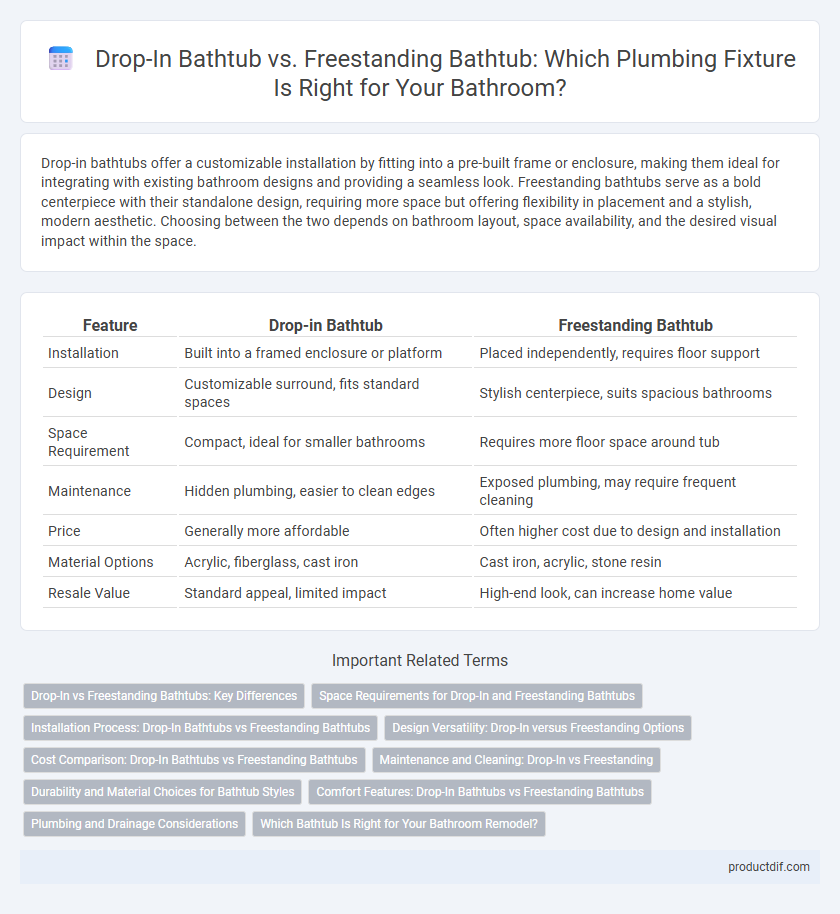Drop-in bathtubs offer a customizable installation by fitting into a pre-built frame or enclosure, making them ideal for integrating with existing bathroom designs and providing a seamless look. Freestanding bathtubs serve as a bold centerpiece with their standalone design, requiring more space but offering flexibility in placement and a stylish, modern aesthetic. Choosing between the two depends on bathroom layout, space availability, and the desired visual impact within the space.
Table of Comparison
| Feature | Drop-in Bathtub | Freestanding Bathtub |
|---|---|---|
| Installation | Built into a framed enclosure or platform | Placed independently, requires floor support |
| Design | Customizable surround, fits standard spaces | Stylish centerpiece, suits spacious bathrooms |
| Space Requirement | Compact, ideal for smaller bathrooms | Requires more floor space around tub |
| Maintenance | Hidden plumbing, easier to clean edges | Exposed plumbing, may require frequent cleaning |
| Price | Generally more affordable | Often higher cost due to design and installation |
| Material Options | Acrylic, fiberglass, cast iron | Cast iron, acrylic, stone resin |
| Resale Value | Standard appeal, limited impact | High-end look, can increase home value |
Drop-In vs Freestanding Bathtubs: Key Differences
Drop-in bathtubs are designed to be installed within a framed enclosure, offering a seamless, built-in look that integrates with surrounding surfaces, making them ideal for customized bathroom layouts. Freestanding bathtubs, in contrast, are standalone units that provide versatile placement options and become focal points due to their sculptural design. Key differences include installation complexity, with drop-in tubs requiring a constructed deck and plumbing concealment, whereas freestanding tubs often allow for easier installation but may require exposed plumbing and sufficient floor space.
Space Requirements for Drop-In and Freestanding Bathtubs
Drop-in bathtubs require a framed enclosure or platform for installation, making them ideal for spaces with designated alcoves or partially enclosed bathrooms. Freestanding bathtubs demand more open floor space around all sides for accessibility and aesthetic appeal, suitable for larger bathrooms or open-concept layouts. Choosing between these options depends on the bathroom's available square footage and the desired design impact.
Installation Process: Drop-In Bathtubs vs Freestanding Bathtubs
Drop-in bathtubs require a framed enclosure for installation, integrating seamlessly into a customized surround that supports the tub and conceals plumbing connections. Freestanding bathtubs are installed independently on the bathroom floor, often requiring reinforced flooring to support their weight and allowing flexible placement without the need for surrounding structures. The drop-in model demands precise measurements and carpentry skills, while freestanding tubs offer easier accessibility for plumbing but may involve more complex floor reinforcement.
Design Versatility: Drop-In versus Freestanding Options
Drop-in bathtubs offer design versatility by fitting seamlessly into customized platforms or alcoves, allowing integration with various tile designs, materials, and bathroom layouts. Freestanding bathtubs provide a striking focal point with their sculptural shapes and mobility, enabling placement flexibility without permanent installation constraints. Both options enhance bathroom aesthetics differently, with drop-in models favoring subtle integration and freestanding tubs emphasizing bold, standalone presence.
Cost Comparison: Drop-In Bathtubs vs Freestanding Bathtubs
Drop-in bathtubs generally cost less than freestanding bathtubs due to simpler installation requirements and reduced need for floor reinforcement. Freestanding bathtubs often have higher price points driven by designer models and increased installation complexity, including the need for exposed plumbing finishes. Budget considerations typically favor drop-in models for renovation projects aiming for cost-efficiency without compromising style.
Maintenance and Cleaning: Drop-In vs Freestanding
Drop-in bathtubs generally offer easier maintenance due to their flush installation, which minimizes exposed surfaces where dust and grime can accumulate. Freestanding bathtubs require more thorough cleaning around the base and underneath, making maintenance slightly more labor-intensive. The smooth, accessible surfaces of drop-in tubs simplify regular cleaning, while freestanding models demand attention to multiple angles to prevent buildup.
Durability and Material Choices for Bathtub Styles
Drop-in bathtubs are commonly constructed with acrylic or fiberglass, offering moderate durability and resistance to chipping but may require reinforced framing for long-term stability. Freestanding bathtubs often feature materials like cast iron, stone resin, or solid surface composites, which provide superior durability and impact resistance, enhancing their longevity in high-use environments. Material choice directly influences maintenance needs and wear resistance, with cast iron freestanding tubs excelling in heat retention and surface hardness compared to lighter drop-in models.
Comfort Features: Drop-In Bathtubs vs Freestanding Bathtubs
Drop-in bathtubs often provide enhanced comfort features such as ergonomic designs and integrated armrests, allowing for a more supportive and cozy bathing experience. Freestanding bathtubs, while offering aesthetic appeal and spacious interiors, may lack built-in comfort elements but compensate with customizable shapes that accommodate various body types. Selecting between drop-in and freestanding models depends largely on prioritizing ergonomic support versus flexible design options.
Plumbing and Drainage Considerations
Drop-in bathtubs require a framed enclosure and hidden plumbing, allowing for easier integration with existing drainage systems but limiting access for future repairs. Freestanding bathtubs have exposed plumbing that demands precise pipe positioning and may require additional floor reinforcement, often necessitating customized drainage solutions. Proper venting and trap alignment are critical for both types to ensure efficient drainage and prevent water backup.
Which Bathtub Is Right for Your Bathroom Remodel?
Drop-in bathtubs fit seamlessly into a framed enclosure, offering a built-in look with customizable decking that supports integrated storage or decor, ideal for bathrooms with limited space or a tailored style. Freestanding bathtubs serve as a striking centerpiece with their sculptural design, requiring more floor space and plumbing flexibility, best suited for larger bathrooms or open layouts where visual impact is a priority. Choosing the right bathtub depends on bathroom size, plumbing configuration, and design preferences, balancing functionality with aesthetic goals for your remodel.
drop-in bathtub vs freestanding bathtub Infographic

 productdif.com
productdif.com